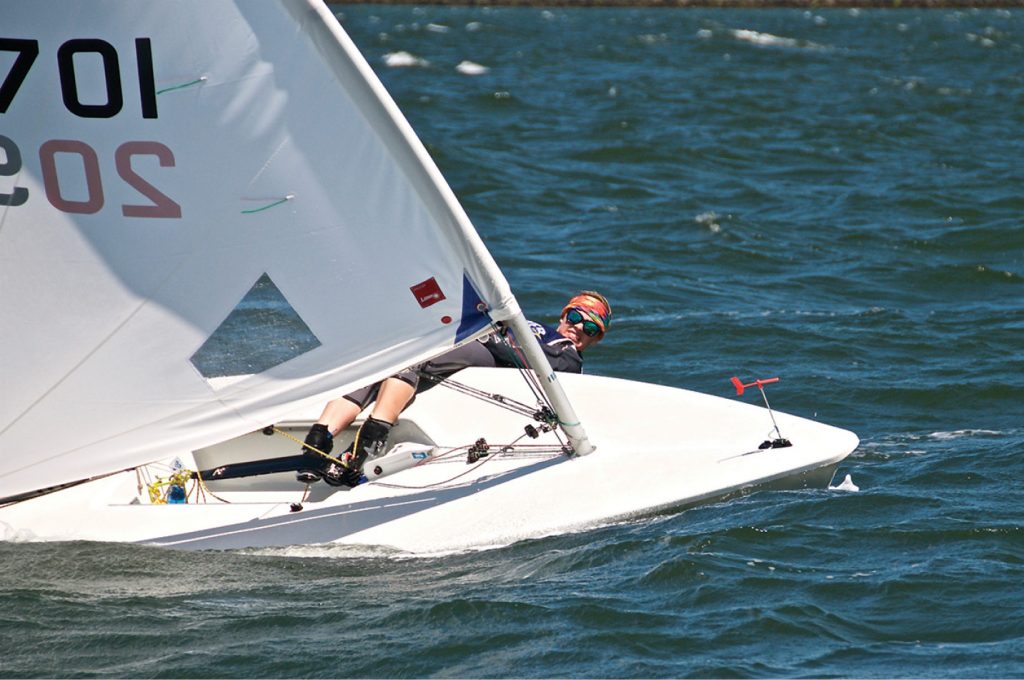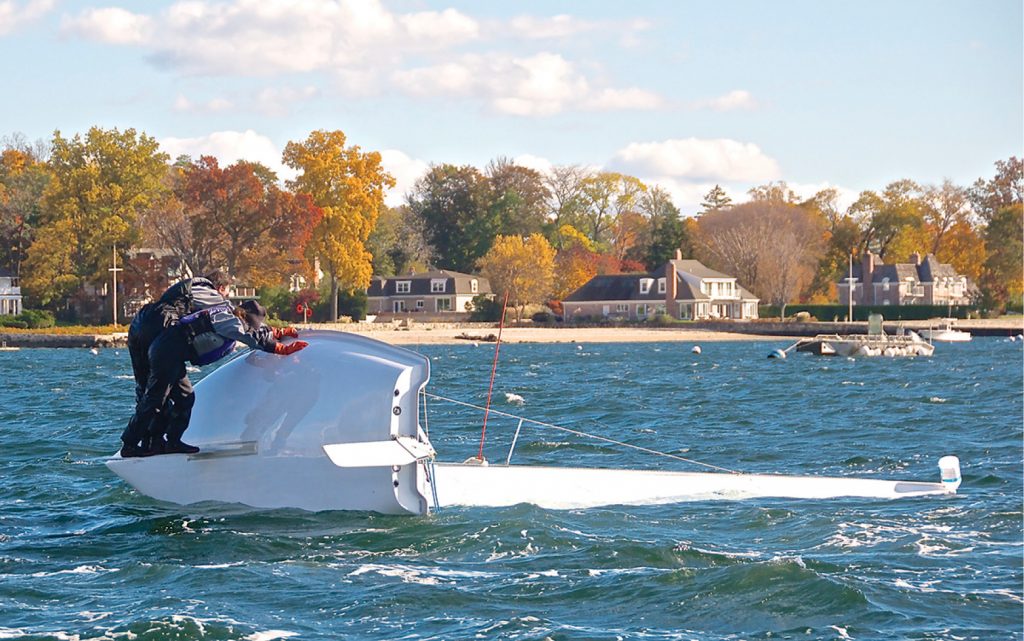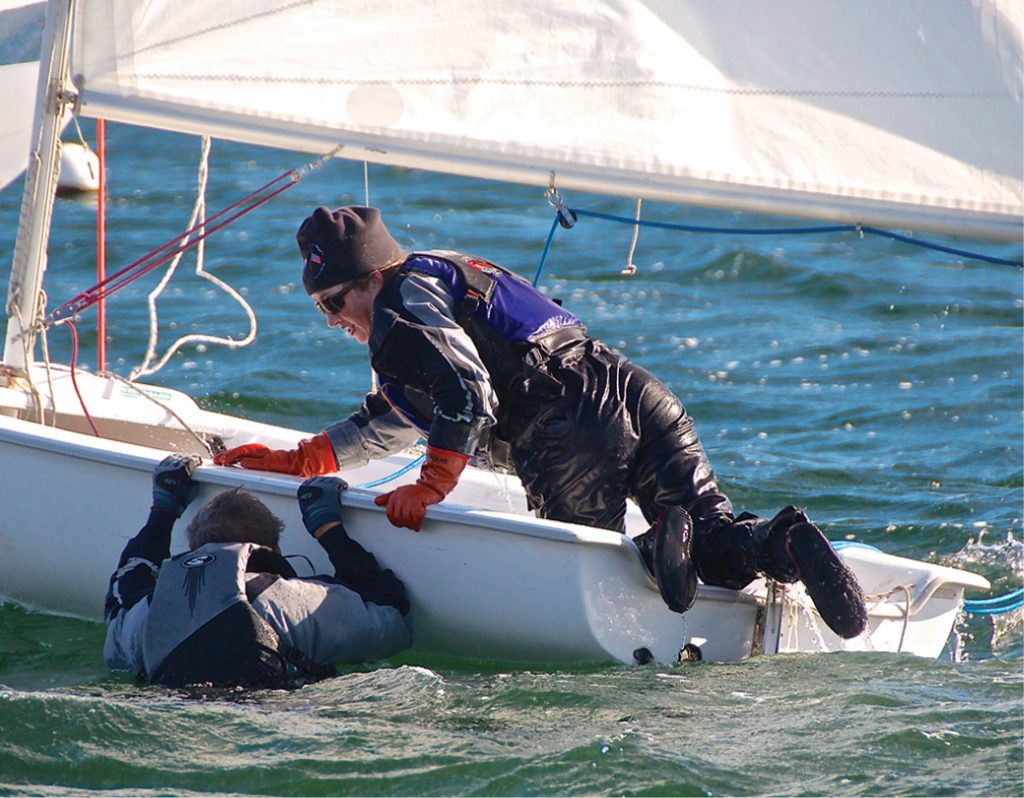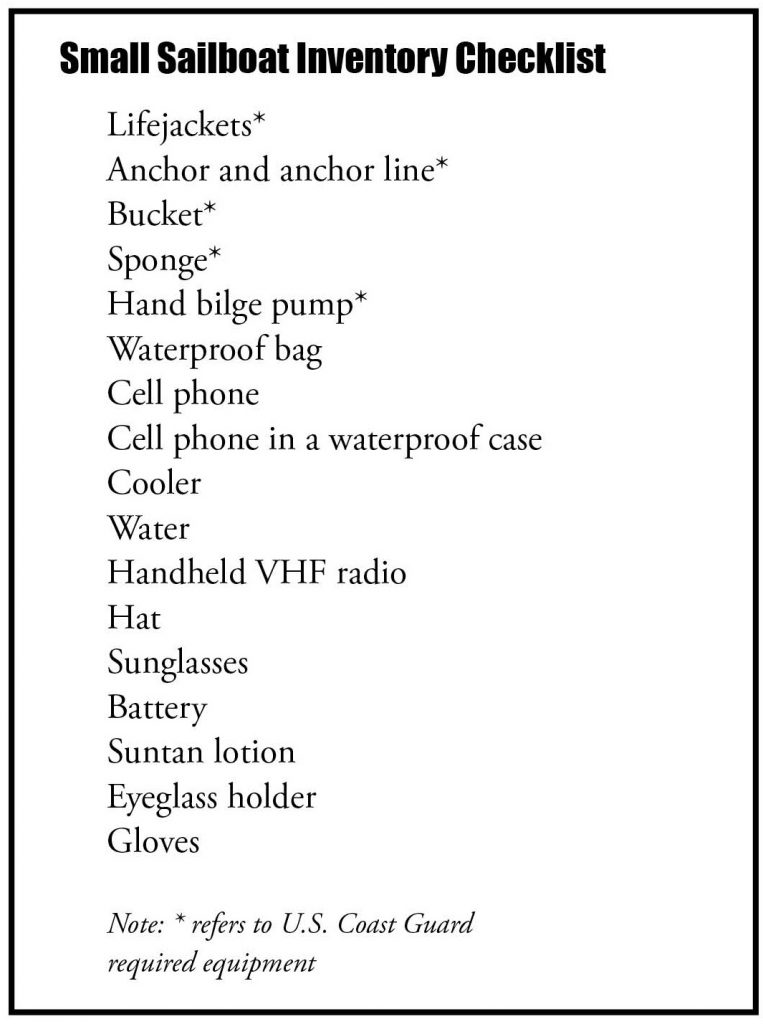How To Right A Capsized Sailboat
By John McCabe

Keeping weight to windward and the centerboard (or daggerboard) fully lowered will reduce the boat'south tendency to capsize in a cakewalk. Photo courtesy of Rick Bannerot/OntheFlyPhoto.internet
On my second date with a young lady in the early 1960s, she and I were sailing on a 19-pes Lightning on the Navesink River in New Jersey. The weather was motion-picture show-perfect, and my date was all dressed up for a solar day on the water. I was at the tiller. At some betoken I had to announce calmly that we were going to invert. Reflecting back on what she heard, she recalls that she had a couple of seconds to retrieve well-nigh what that meant, so, suddenly, she was up to her neck in the h2o. It all worked out OK though – nosotros'll soon exist jubilant our 50th wedding anniversary! I take had the opportunity to be on a number of boats since then and have learned some of import lessons on how to continue a modest sailboat from capsizing and what to do if it does.
Take in listen that any sailboat tin can capsize, but let's describe what "capsize" means. The mainsail prevents about boats from going over more than 90 degrees – at to the lowest degree for a short time. The mast, if made of metal, is hollow, and the air in the mast will keep information technology afloat, at least until it fills with water. With a sailboat with a fixed keel, the weight of the keel will right the boat more or less adequately soon. While sailing with a centerboard, the board will inhibit the boat from capsizing and like a keel, will push the boat forward when the wind hits the boat at an angle, rather than moving the boat straight sideways. When a sailboat has its centerboard down, the gunkhole volition be less likely to capsize, but if it does, the centerboard will help. With a little attempt the centerboard volition indeed help right the boat as discussed below.
What causes a pocket-size sailboat to capsize? Information technology is oft the misalignment of weight, non just the wind. Indeed, fifty-fifty in low-cal wind, if the weight is misaligned, the gunkhole can tip over. Weight sources are people and chiefly the boom! When the weight of people is on one side, the tipping of the boat will cause the blast to motion to that side by the force of gravity, not necessarily the wind. Indeed, in low-cal winds the force of gravity on the smash tin have a greater outcome on the position of the boom than the strength of the wind! Thus, in light air there is still the potential of capsizing if both the weight of people and boom are on one side. This brings us to the first rule that must be followed:
Rule one: The centerboard must be fully down at all times when a sheet is up.
Now, at that place may exist times with the boat goes ashore. For a keelboat, you can put the motor in reverse equally stiff every bit possible to run across if the boat can be backed out of the mud or sand. At the same time you lot can try to rock the gunkhole. For a small sailboat with the centerboard down, you lot can try to use the motor. Preferably, however, you should use an oar to push off from the lesser or oars to row off the bottom. The outboard motor propeller, if fabricated of plastic, is meant to pause if it hits a stone or a hard bottom. At this point, information technology is very tempting to raise the centerboard a few inches to loosen the boat from the bottom. But exercise non do this – you lot gamble capsizing! Outset, take the canvass downwardly. Then maneuver the boat off the bottom using the oars, motor or other method. Over again, fully lower the canvas before raising the centerboard even an inch. Notation Rule 1, above.
Rule 2: Don't stand upwards in a modest sailboat when underway.
This rule helps in weight distribution in as to the lowest degree three ways. First, because of the boom, it may exist harder to move your body to the correct location on the boat, and second, if the boom, considering of gravity or the wind, hits your body (hopefully not your head), it reinforces the force to capsize the boat at a college heart of gravity. Third, if your trunk or head is at or above the level of the boom, the blast cannot move to let the air out of the mainsail. This exacerbates the forcefulness that volition tip the boat. Note that standing up is not the sole factor that can crusade a gunkhole to invert, just it can exist a contributing gene. At all times, continue low and be prepared to uncleat the mainsheet and let the canvas out. Be prepared to shift weight quickly if necessary, but otherwise continue a low profile and motion slowly. In summary, don't stand in a minor sailboat, except perhaps while boarding.

If you lot've capsized, climb onto the centerboard, catch the rail and apply your weight to lever the boat upright. Note the empty 1-gallon bottle tied to the masthead, which helps prevent the gunkhole from turning turtle. Photo courtesy of Rick Bannerot/OntheFlyPhoto.net
Dominion 3: Be prepared at all times to allow out the mainsheet or turn into the wind, or both, in moderate or heavy winds.
The recommendation hither is the sailors should at all times know where the wind is coming from, its force, and where your boat is in relation to the air current. Go along your mitt on the mainsheet so that it tin be loosened and readjusted hands at any time. Also, go along your manus on the tiller and then that the direction of the boat can be adjusted promptly. At all times exist prepared to unclog the master sail and let the sail out. Also, when do you reef the master sail? Equally presently as you retrieve of it! – one-time crewman wisdom. Note that the further the boom and sheet are permit out the more weight is put toward the side where the boom is located. Merely, ironically, you should permit the sail out considering it will catch less air current! Let it out a little or a lot, in your judgment. Alternatively, turn the boat into the air current. The preferred approach is to cull your direction, and then adapt the sails to reach that direction, if possible.
Once you are on a tack in a small-scale boat, exercise not jibe (change management past turning in the direction the wind is blowing towards) except in light winds because you risk capsizing. Always "come about" (plough in the management the wind is coming from) and phone call out in a strong enough vox "COMING ABOUT!" so all on lath know what is happening and tin change their position to be on the windward side of the boat. You can besides say, "difficult to lee" pregnant the tiller is moved quickly and fully to the leeward side of the boat (in the direction the current of air is bravado toward) forcing the boat to turn into the wind. Always take the mainsheet in mitt, and I would suggest wearing gloves. Gloves too keep the crewman'southward hands from getting sunburned, an added benefit. In summary, when at risk for capsize, allow out the mainsheet and/or plough into wind. Preferably, permit out the mainsheet.

Climb back aboard from the bow or stern. Attempting to board from the side may cause the boat to flip once more. Photo courtesy of Rick Bannerot/OntheFlyPhoto.net
Dominion 4: On a modest sailboat, do not use the motor when the sail is up.
This rule may surprise some sailors. In a larger gunkhole with a keel, y'all need to turn the motor on before bringing down the main sail because you will have no control over the boat direction when there are no sails upward. On the other hand, in a small centerboard sailboat, if the motor is on and the coiffure is in the process of taking down the sails in that location is a risk of capsizing while the motor is in gear. This is dangerous considering the prop will go on to turn even with the boat turned over 90 degrees. That presents a run a risk to those who may at that point be in the h2o. Understand that the motor can continue running if the boat capsizes unless information technology is shut off either past twisting the handle or using a magnetic disk release (See Rule 5). On a small sailboat, the motor must be off when taking the sails down. The boat will naturally head into the wind if the tiller is let go.
Rule 5: Use a magnetic disk engine shutoff and wristband when ii or more people are on the gunkhole.
Some electric outboard motors have a magnetic disk and a pad that will close the motor off when and if the magnetic disk is separated from the pad. The magnetic deejay has a wristband that may be used past the operator belongings the tiller on the outboard. It is a expert thought to use this wristband when underway with the outboard in gear. This is particularly true when there are two or more than individuals on lath a small boat. Once again, if the boat capsizes or there is a man overboard, the motor will proceed to run and the propeller plough unless the motor is shut off. This may be difficult to do in an urgent state of affairs or if a sudden, unexpected event occurs.
What to practice if the small sailboat capsizes
A modest sailboat may invert, just it can be expected to turn over initially not more than about xc degrees. This is enough to fill the gunkhole with water and if left in that position, the mast may go down farther in the h2o making the challenge of righting the boat more difficult. Appropriately, if the boat capsizes, take the following steps as rapidly as possible:
- Account for all who were on board. Catch the lifejackets and put them on. Of course, make sure the life jackets are easily accessible before departure. [Better still, put them on earlier leaving the dock – Ed.] For inexperienced passengers, make sure their lifejackets are on before putting on your lifejacket. Of class, children 12 and under must article of clothing lifejackets at all times. Always have lifejackets on lath for all persons on board. An extra lifejacket can be tied to or placed on the top of the mast, which will keep the mast from sinking further into the h2o.
- Swim to the bottom side of the boat and stand on the centerboard, grabbing the track until the boat rights itself. The gunkhole will notwithstanding exist full of h2o, just it'south unlikely to sink. The h2o may even be at a level that is slightly below the edges of the coamings. Still, water may be sloshing in and out of the boat at this time.
- Then enter the boat from either the bow or the stern – not the side. The bow will usually be ameliorate as the weight on the bow volition not result in lowering the cockpit below the waterline and the motor in the back represents weight there. Hopefully, if there is a hole in the stern for the tiller, that hole will be moved above the waterline. The boat volition float only it tin can still accept on water. If't is easier to lath the gunkhole from the stern, that'south OK too.
- Once in the cockpit, grab a bucket placed in the gunkhole earlier (notation boat inventory list below). And so, move to the forward side of cockpit to sit and bail. Why? The hole in the stern for the rudder will let in water and yous may forbid this past being in the forrad finish of the cockpit. The tiller should be gratuitous, and the boat volition commonly point into the wind. Next, lower the sails if you can in this timeframe.
- The best position to sit when bailing out the boat is the forward portion of the cockpit, i.e., towards the bow. The coiffure member in the cockpit should place his or her back against the front of the cockpit (bow terminate of the coaming). If a second person is present, he or she should be in h2o at the bow to hold down the bow. Positioning the gunkhole like a banana will assistance in the bailout. Using the bucket, the crew fellow member in the cockpit should bond the water out of the cockpit furiously in the beginning, until the water in the gunkhole is at a level that he or she tin can bail at a more comfortable pace. It is quite feasible to remove 100% of the water from the boat using a combination of the bucket, a hand bilge pump and a sponge. When most of the h2o is out of the boat, a crew member in the water can enter the gunkhole from the stern (not the side), being careful non to tip the boat over again.
- Wave for help if necessary. Likewise, if possible, a "Mayday" can be sent on VHF channel 16, monitored past the U.South. Coast Guard, or call 911 on your cell phone. Hopefully, the canvass can be hoisted again and the boat tin go along to its destination.
Pocket-size Boat Inventory Checklist

If you avert capsizing, you save grief, budgetary loss (prison cell phone?) and perhaps greater risk. Safe sailing! I welcome any comments you may accept on this article. Feel complimentary to send them to john@mccabestudio.com. ■
John McCabe is a professional artist with a focus on portraiture (www.mccabestudio.com). He has studios in Milford, CT and Great Falls, VA. He and his wife, Peggy, have four children and seven grandchildren. They all sheet out of Milford Harbor.
Source: https://www.windcheckmagazine.com/article/how-to-keep-a-small-sailboat-from-capsizing-and-what-to-do-if-it-does/

0 Response to "How To Right A Capsized Sailboat"
Post a Comment